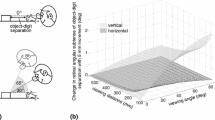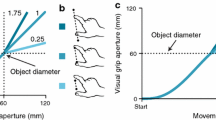Abstract
The contribution of binocular visual feedback to the kinematics of human prehension was studied in two related experiments. In both experiments, the field of view of each eye was independently controlled by means of goggles fitted with liquid-crystal shutters. While wearing these goggles, which permitted either a binocular or a monocular view of the world, subjects were required to reach out and grasp a target object, which varied in size and position from trial to trial. In experiment 1, two viewing conditions were used. In one condition, binocular vision was available throughout the entire trial; in the second condition, the initial binocular view was replaced by a monocular view after the reaching movement had been initiated. When only monocular feedback was available, subjects showed a prolonged deceleration phase, although the time they spent in contact with the object was the same in both conditions. In experiment 2, monocular vision was available throughout a given trial in one condition and was replaced by binocular vision upon movement initiation in the second condition. Subjects in this experiment also displayed a prolonged deceleration phase in the monocular feedback condition relative to their performance in the binocular feedback condition. Unlike experiment 1, however, allowing only monocular feedback resulted in an increase in the amount of time subjects spent in contact with the object. Moreover, the object contact phases under the two conditions of experiment 2 were much longer than those observed in experiment 1, in which subjects received initial binocular views of the object. This latter finding suggests that an initial binocular view provides better information about the size and location of the object-information that allows subjects to form their final grasp more efficiently. In summary, these findings make it clear that binocular vision makes important contributions to both the planning and the on-line control of skilled, visually guided reaching and grasping movements.
Similar content being viewed by others
References
Bishop PO (1989) Vertical disparity, egocentric distance and stereoscopic depth constancy: a new interpretation. Proc R Soc Lond [Biol] 237:445–469
Cumming BG, Johnston EB, Parker AJ (1991) Vertical disparities and perception of three-dimensional shape. Nature 349:411–413
Fisk JD, Goodale M (1988) The effects of unilateral brain damage on visually guided reaching: hemispheric differences in the nature of the deficit. Exp Brain Res 72:425–435
Foley JM (1980) Binocular distance perception. Psychol Rev 87:411–434
Goodale MA, Pelisson D, Prablanc C (1986) Large adjustments in visually guided reaching do not depend on vision of the hand or perception of target displacement. Nature 349:154–156
Hering E (1861) Beitrage zur Physiologie, Heft 1. Englemann, Leipzig
Hochberg J (1971) and Perception. II. Space and movement. In: Kling JW, Riggs LA (eds) Woodworth and Schlosberg's experimental psychology. 3rd edn. Holt, Rinehart and Winston, New York, pp 475–550
Huynh H, Feldt LS (1976) Estimation of the Box correlation for degrees of freedom from sample data in randomized block and split-plot designs. J Educ Stat 1:69–82
Jakobson L, Goodale M (1991) Factors affecting higher-order movement planning: a kinematic analysis of human prehension. Exp Brain Res 86:199–208
Jeannerod M (1988) The neural and behavioural organization of goal-directed movements. Clarendon, Oxford
Longuet-Higgins HC (1982) The role of the vertical dimension in stereoscopic vision. Perception 11:377–386
Oldfield RC (1971) The assessment and analysis of handedness: the Edinburgh inventory. Neuropsychologia 9:97–112
Paulignan Y, Jeannerod M, MacKenzie C, Marteniuk R (1991) Selective perturbation of visual input during prehension movements. 2. The effects of changing object size. Exp Brain Res 87:407–420
Paulignan Y, MacKenzie C, Marteniuk R, Jeannerod M (1991) Selective perturbation of visual input during prehension movements. 1. The effects of changing object position. Exp Brain Res 83:502–512
Previc FH (1990) Functional specialization in the lower and upper visual fields in humans: its ecological origins and neurophysiological implications. Behav Brain Sci 13:519–575
Regan D (1991) Depth from motion and motion in depth. In: Regan D (ed) Binocular vision Macmillan, London, pp 137–169
Regan D (1992) Visual judgements and misjudgements in cricket, and the art of flight. Perception 21:91–115
Regan D, Frisby JP, Poggio GF, Schor CM, Tyler CW (1990) The perception of stereodepth and stereomotion: cortical mechanisms. In: Spillmann L, Werner JS (eds) Visual perception: the neurophysiological foundations. Academic, New York, pp 317–347
Rogers BJ, Bradshaw MF (1993) Vertical disparities, differential perspective and binocular stereopsis. Nature 361:253–255
Servos P, Goodale MA, Jakobson LS (1992) The role of binocular vision in prehension: a kinematic analysis. Vision Res 32:1513–1521
Soechting JF (1984) Effect of target size on spatial and temporal characteristics of a pointing movement in man. Exp Brain Res 54:121–132
Author information
Authors and Affiliations
Rights and permissions
About this article
Cite this article
Servos, P., Goodale, M.A. Binocular vision and the on-line control of human prehension. Exp Brain Res 98, 119–127 (1994). https://doi.org/10.1007/BF00229116
Received:
Accepted:
Issue Date:
DOI: https://doi.org/10.1007/BF00229116




